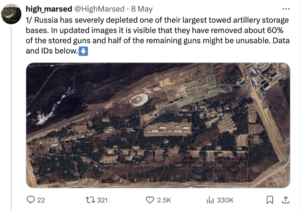The Institute for the Study of War (ISW) released an assessment this week, suggesting that Russian equipment losses in Ukraine have reached such significant levels that replenishment will pose a challenge, particularly as Moscow taps into its extensive reserves of Soviet-era vehicles.
According to reports based on satellite imagery, Russian military depots have seen a notable depletion of vehicles throughout the course of the conflict in Ukraine.

Open-source intelligence from the X account known as Jompy, which monitors Russian military depots, indicated a substantial decrease in armoured fighting vehicles (AFVs).
The data revealed a decline of nearly a third (32 percent) in Russian stores of AFVs compared to prewar levels, dropping from 15,152 in 2021 to 10,389, reflecting a loss of 4,763 units.
Further analysis by Jompy indicated that Russia has predominantly withdrawn its MT-LB multipurpose AFVs from storage, leaving only 922 units, down from 2,527 prewar.
Additionally, the inventory of BMD airborne amphibious tracked infantry fighting vehicles (IFVs) has diminished significantly, with only 244 remaining compared to 637 before the invasion.
The dwindling reserves also extend to other vehicle models, including newer variants of BTR-60s, 70s, and 80s. Jompy estimated that Russia now fields between 1,000 and 2,000 of its remaining MT-LB multi-purpose, amphibious AFVs.
A prior assessment by the British International Institute for Strategic Studies (IISS) on February 12th suggested that Russia could potentially sustain its annual rate of vehicle losses, exceeding 3,000 AFVs, for a period of two to three years by reactivating vehicles from storage.
The IISS reported that Russian forces incurred losses of over 3,000 AFVs in the previous year and approximately 8,000 vehicles throughout the course of the conflict, necessitating the reactivation of at least 1,180 main battle tanks and around 2,470 IFVs and armored personnel carriers from storage.

Meanwhile, open-source intelligence from account High_Marsed revealed on Wednesday that satellite imagery indicated Russia had removed approximately 60 percent of its artillery systems from a towed artillery storage base during the conflict.
However, it was noted that a significant portion of the remaining artillery systems at the base may be unusable due to degradation in storage and obsolescence, rendering them incompatible with modern ammunition.
The ISW emphasised that the losses incurred by Russia in its Soviet-era vehicle reserves exceed the capacity of its defence industrial base to compensate, foreseeing a lengthy period before replacements could be sourced.
The think tank warned that Russia would likely face challenges in adequately supplying its military units with materiel in the long term without transitioning the economy to a wartime footing, a step that President Putin has thus far been reluctant to take.
Click here for more News & Current Affairs at EU Today
_________________________________________________________________________________________________________

Follow EU Today on social media:
Twitter: @EU_today
Facebook: https://www.facebook.com/EUtoday.net/
YouTube: https://www.youtube.com/@eutoday1049




